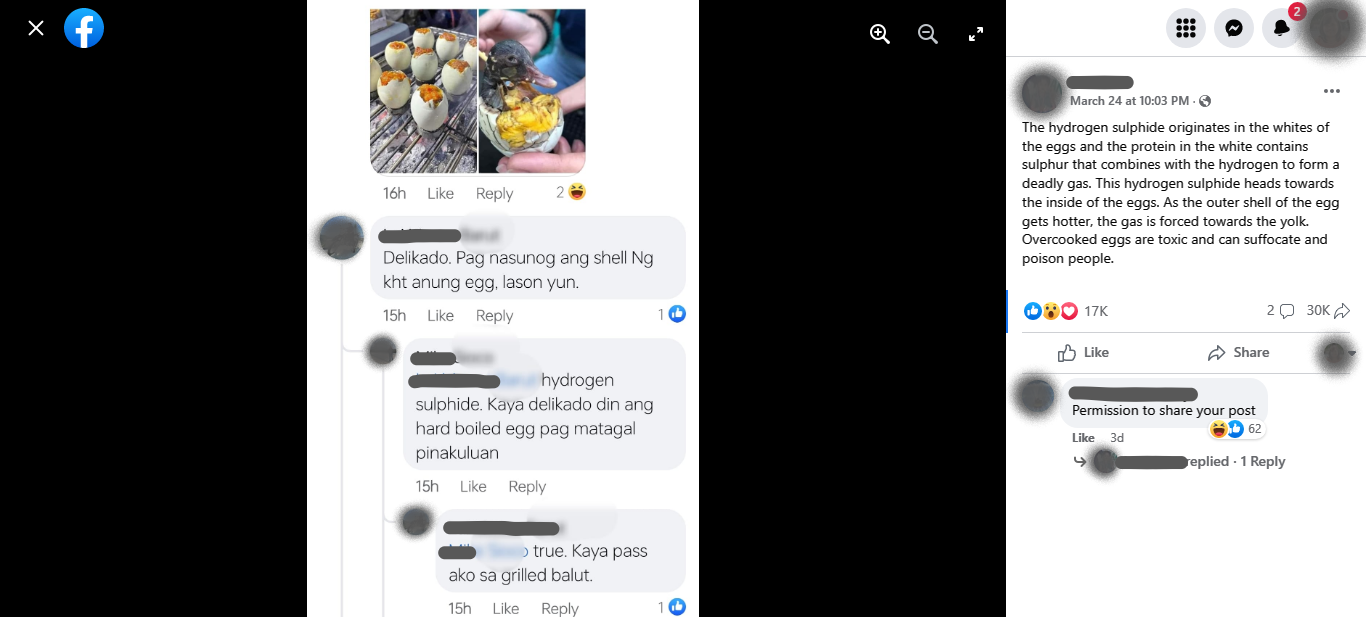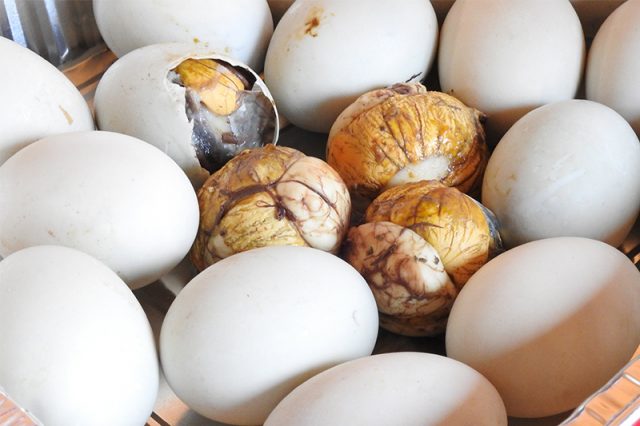“Not considered detrimental to human health.”
This was what an organization of food technologists said in response to online claims that consuming grilled “balut” and overcooked eggs are supposedly “toxic” for humans.
Last Friday, a Facebook user shared a screengrab of a post’s comment section with pictures of the egg delicacy popular among Pinoys.
“Delikado. ‘Pag nasunog ang shell ng [kahit anong] egg, lason ‘yun,” a commenter in the screengrab claimed.
“Hydrogen sulfide. Kaya delikado din ang hard boiled egg ‘pag matagal pinakuluaan,” another commenter alleged.
“True. Kaya pass ako sa grilled balut,” the first commenter in the screengrab responded.
The Facebook user who shared a picture of the exchange then claimed:
“The hydrogen sulphide originates in the whites of the eggs and the protein in the white contains sulphur that combines with the hydrogen to form a deadly gas. This hydrogen sulphide heads towards the inside of the eggs. As the outer shell of the egg gets hotter, the gas is forced towards the yolk. Overcooked eggs are toxic and can suffocate and poison people.”

The Facebook post has reached viral status with over 17,000 likes and reactions and 30,000 shares so far.
On Sunday, the Alpha Chapter of the Philippine Association of Food Technologists (PAFT) debunked its claims and said that eating grilled balut or fertilized duck egg “cannot pose any health risks.”
Hydrogen sulfide, it said, is formed when the proteins of the egg whites — which contain sulfur — react with hydrogen during the heating of the eggs.
While hydrogen sulfide is a toxic gas, PAFT-Alpha Chapter said it is “released in such small amounts that it cannot pose any health risks.”
“For additional context, the highest H2S concentration that can be produced by an egg is around 0.2 ppm which happens when the egg is already rotten,” it added.
H2S is the scientific symbol for hydrogen sulfide, while ppm pertains to parts per million in measurement.
“Meanwhile, the allowable exposure limit for H2S is 20 ppm and must reach a concentration of 100 ppm in order to cause dangerous effects on health and life,” PAFT-Alpha Chapter added.
It also explained that the dark greenish tinge seen on egg yolks, when it is overcooked, is “not considered detrimental to human health.”
The org said that this happens when the hydrogen sulfide goes inwards toward the egg yolk due to the decreased solubility of the egg white as the heating prolongs.
“This gas reacts with the iron subsequently released from the yolk during heating, forming iron sulfide,” it added.
The PAFT-Alpha Chapter concluded its post by emphasizing that it is “safe” to eat grilled balut.
“Kapag niluluto ang itlog, nabubuo ang hydrogen sulfide (H2S) ngunit hindi ito sapat upang magdulot ng panganib sa kalusugan,” it added.
A former quality assurance intern at Chef’s Secret, Inc also said the viral Facebook post is “misleading.”
“Yes, hydrogen sulfide usually is toxic. However, the amount or level of hydrogen sulfide formed during the heating of eggs is not high enough to cause serious health issues. In fact, hydrogen sulfide is naturally occurring in the human body,” Alvier Remollo wrote.
“According to the Centers for Disease Control and Prevention (CDC), even the bacteria in our mouth and gastrointestinal tract produce hydrogen sulfide while digesting food containing vegetable or animal proteins. Additionally, when hydrogen sulfide enters the human body, it will be converted to sulfate, which later on is excreted in the urine,” he added.
Remollo also shared a link to a document released by the United States’ national public health agency to prove his claim.







